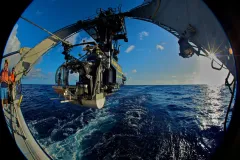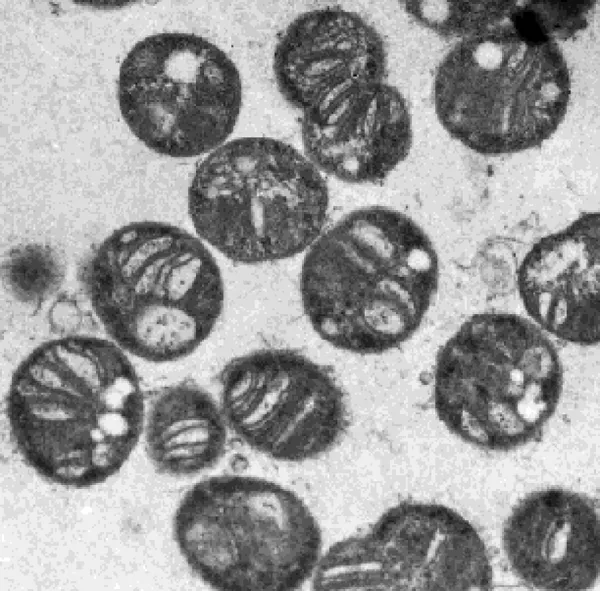How Methane Fueled a Food Web after the Gulf Oil Spill

In August 1994, Mandy Joye dove to the deep sea in a submersible for the first time. A newly-minted Ph.D., she had recently completed her graduate studies on marine microbes living in unusual environments, and on that day she was searching for microbes that live on methane. Methane is a greenhouse gas probably best known for being emitted by burping and farting cows, but it also leaks from deep in the earth's crust through cracks in the seafloor called methane seeps. The sight of a bubbling methane seep through the window of the Johnson Sea Link submersible on that day changed her life. "When the lights came on over the seafloor at this cold seep, I was just like: How could I have not known how cool this was?" Dr. Joye said. "I was totally addicted."
Little did she know, 16 years later she would be on the front lines studying the biggest deep-sea methane injection known in human history—and the microbes she studied would be central to the methane's ultimate fate. When the Deepwater Horizon oil rig exploded in April 2010, 3.19 million barrels of oil spilled into the Gulf of Mexico from a deep sea well over the course of three months. Dr. Joye, now a microbial geochemist at the University of Georgia and a lead researcher with the Gulf of Mexico Research Initiative (GoMRI), knew that something else would be flowing out of the Macondo well: methane, and lots of it. Methane often forms alongside oil in fossil fuel reservoirs deep underground, and around 40 percent of the Macondo reservoir was methane. No one knew how so much methane would behave at such depths, or how microbes would respond to it. But thanks to Dr. Joye and other GoMRI researchers, we now understand far more about how methane can fuel the food web in the Gulf of Mexico.
Dr. Joye knew she had to act fast if she wanted to learn how microbes respond to such a massive methane infusion in the deep sea. By May 5, just two weeks after the spill began, her team was out on the water to collect the first deep-sea water samples from around the wellhead. Along with her colleagues, she collected more than 2,000 water samples on ten research cruises, with the last collected on December 3, 2010, months after the spill was officially over. Back in the lab, her crew measured methane and microbes in each sample to reconstruct methane dynamics in the area around the well. Because the gas was released in cold, deep water under a lot of pressure, it dissolved instead of bubbling to the surface, and formed a cloud-like plume at around 4,000 feet (1,200 meters) depth. Dr. Joye's samples showed that around 70,000-times more methane was present in this plume than in the surrounding water.
Once dissolved, methane is available to be eaten by microbes. Just 11 days after the start of the spill, there were already methane-eating microbes, called methanotrophs, growing in the plume. "This is not an organism that was common or abundant" in the Gulf prior to the spill, said Dr. Joye. "They were there in very low abundance, but when put in the right conditions, they flourished." They grew slowly at first, but once they reached their peak in early June, the microbes were consuming methane at among the fastest rates ever reported for the open ocean—some 60,000-times faster than methanotrophs living at a methane seep.
But not for long. By mid-June, the amount of methane in the plume samples started dropping, and with it, the number of methanotrophs. The spill was ongoing at this point, so where did the methane go? Dr. Joye suspects that a change to the pipe at the wellhead is the culprit. For the first month of the spill, a piece of the riser pipe was attached to the well, which like a hose spewed a strong, direct jet of oil and gas into the water. But on June 3, BP cut the pipe off, causing the oil and gas to flow more gently in an umbrella-like shape. Once the jet was gone, the plume stopped growing and began to disperse—and without a high concentration of methane to feed upon, the microbes dispersed as well. Through the rest of the year, the methane concentration continued to drop as it was "infinitely diluted to the point where you can't measure it," she said. By December, it was back to normal levels for the Gulf of Mexico.
Although methane was gone from the water column, it could live on in the food web if the methanotrophs became food for other organisms. This is the question Jeff Chanton, a chemical oceanographer at Florida State University and lead researcher with GoMRI, investigated using atomic forensics. To trace the atoms that originate in methane into the food web, Dr. Chanton exploited a unique quality of carbon atoms (also used in carbon dating). When plants turn sunlight into energy, the new carbon atoms carry a chemical signal—sometimes called "new carbon"—that fades away over thousands of years, after which it becomes "old carbon." Oil and gases like methane are millions of years old and thus made of purely old carbon. If plankton ate methanotrophs from the plume during the oil spill, those plankton should have more old carbon than run-of-the-mill Gulf of Mexico plankton, which typically eat food loaded with new carbon.
Dr. Chanton collected samples of "particulate organic carbon"—the floating remains of dead plankton known as marine snow—from the Gulf in 2011 and 2012. His atomic forensics showed that the particles of organic carbon collected in deeper waters where the methane plume had existed contained more old carbon than those closer to the surface. However, surface-collected zooplankton also contained some of this old carbon, indicating that they fed on methanotrophs or other methane particles from the spill, introducing them into the food web.
Even if only a portion of the methane that poured into the Gulf was degraded by methanotrophs and introduced to the food web, that is a lot of potential extra food for larger organisms. Frank Hernandez, a fisheries oceanographer at the University of Southern Mississippi and lead researcher with GoMRI, suspects that it may have benefited plankton populations in the year of the spill. He collected plankton samples twice a month at multiple sites in the Gulf during the oil spill to compare to samples he had collected before the spill.
After identifying and counting the different kinds of zooplankton (which are important prey items for larval fishes), Dr. Hernandez saw that when oil pollution was highest in May and June, the zooplankton community changed. By July, however, it resembled those encountered during previous years. Somewhat surprisingly, many species were found in greater numbers during the oil spill than in previous, non-spill years. There are a number of possible explanations for this population growth, and we will probably never know the cause for sure, he said. But one possibility is that these zooplankton had more food than normal because of the large number of methanotrophs in the plume, which allowed them to feed, grow and reproduce despite the pollution in the water.
The results of this unintentional experiment—what happens when millions of barrels of methane spew into the deep ocean?—was a surprise for everyone, and shows how little we know about the deep sea and its microbial denizens. The methane neither bubbled up to the surface, entering the atmosphere as a greenhouse gas, nor was it entirely consumed by microbes. But it changed the Gulf ecosystem by providing a food source for rare methanotrophs and other organisms higher up the food web, at least temporarily.
___
The Ocean Portal receives support from the Gulf of Mexico Research Initiative (GoMRI) to develop and share stories about GoMRI and oil spill science.
The Gulf of Mexico Research Initiative (GoMRI) is a 10-year independent research program established to study the effect, and the potential associated impact, of hydrocarbon releases on the environment and public health, as well as to develop improved spill mitigation, oil detection, characterization and remediation technologies. For more information, visit http://gulfresearchinitiative.org/.




